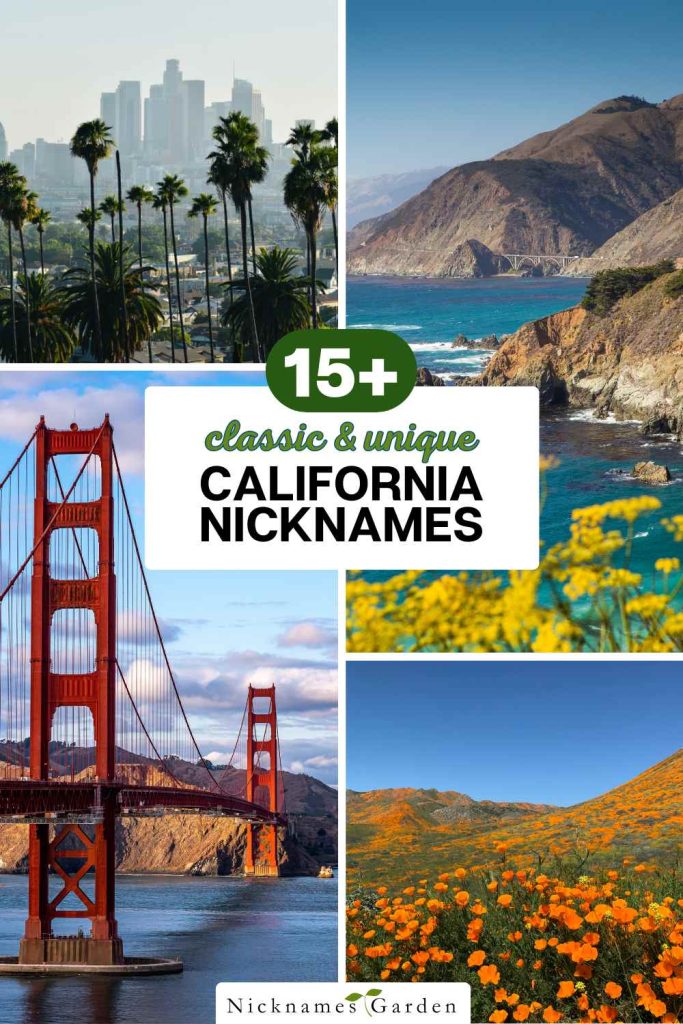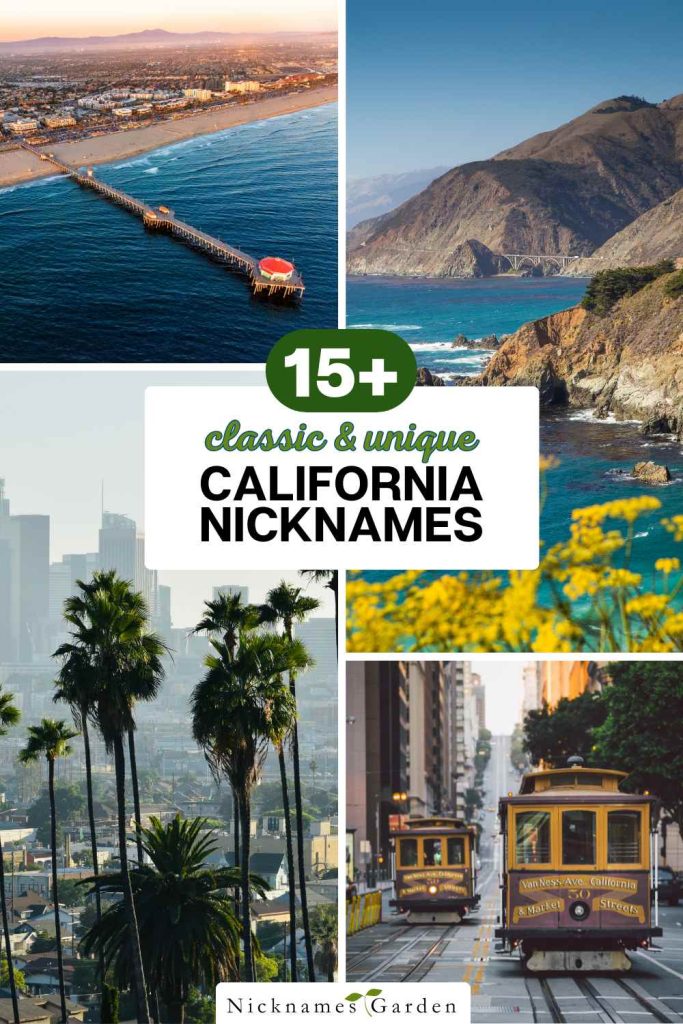California, known for its diverse culture and stunning landscapes, boasts a plethora of nicknames.
From “The Golden State” to quirky monikers like “Hollyweird,” explore the rich history and unique charm behind each name. Join us as well explore all the favorite nicknames for Cali!
Common Nicknames for California
The Golden State
Origin and History:
- The nickname “The Golden State” dates back to the mid-19th century during the California Gold Rush, which began in 1848.
- Gold seekers, known as “forty-niners,” flooded the state in hopes of striking it rich, giving California an enduring association with wealth and opportunity.
Significance:
- The term embodies the state’s image of prosperity and abundance, not just from its historical gold reserves but also from its diverse natural resources and booming economy.
- The golden poppy, the state flower, also contributes to this nickname, symbolizing the state’s natural beauty and golden hillsides in spring.
Popular Usage and References:
- “The Golden State” is widely used in marketing and tourism, emphasizing California’s allure and promise of a better life.
- The nickname appears in songs, films, and literature, reinforcing its iconic status. For example, it’s referenced in the song “California Girls” by The Beach Boys.
Cali
Informal and Casual Use:
- “Cali” is a popular shorthand among residents and visitors alike, representing a casual, laid-back vibe synonymous with the California lifestyle.
- This nickname is often used in everyday conversation, on social media, and in various forms of pop culture.
Cultural References:
- Numerous songs feature “Cali,” such as “California Love” by Tupac Shakur and “Going Back to Cali” by LL Cool J.
- The nickname is frequently seen in hashtags and captions on social media, embodying the state’s cool and relaxed attitude.
Perceptions by Locals and Outsiders:
- While “Cali” is loved by many outsiders for its trendy and cool connotation, some locals prefer traditional nicknames and may find “Cali” less appealing.
- It represents a modern, youthful image of the state, appealing to a younger generation.
The Land of Milk and Honey
Biblical Reference and Historical Context:
- “The Land of Milk and Honey” is a biblical reference, symbolizing a land of abundance and prosperity.
- Early settlers and immigrants perceived California as a place of endless opportunities and natural wealth.
Economic Prosperity and Agricultural Significance:
- California’s fertile land and favorable climate make it one of the most productive agricultural regions in the world.
- The state produces a significant portion of the nation’s dairy products, fruits, and vegetables, earning this nickname due to its agricultural bounty.
The Sunshine State
Climate and Weather:
- Known for its sunny weather and mild climate, California attracts people seeking warmth and an active outdoor lifestyle.
- Its Mediterranean climate offers abundant sunshine, especially in Southern California, making it a favorite destination for beachgoers and nature enthusiasts.
Comparison with Florida’s Nickname:
- Although Florida is officially “The Sunshine State,” California’s sunny reputation often leads to the nickname being applied here as well.
- Despite the confusion, California’s association with sunny weather remains strong.
Tourism and Lifestyle Implications:
- The nickname promotes the state’s outdoor lifestyle, encouraging tourism related to beaches, national parks, and other recreational activities.
- California’s appeal as a destination for sun-seekers is a significant draw for tourists from around the world.
The Bear Flag State
Origin of the Bear Flag:
- The Bear Flag originates from the Bear Flag Revolt in 1846, when a small group of American settlers in California declared independence from Mexico.
- The flag they created featured a bear, symbolizing strength and determination, and became an enduring symbol of the state.
Historical Significance and State Symbols:
- The bear on the flag represents the state’s strength and courage, reflecting the spirit of those who fought for California’s independence.
- The star on the flag signifies sovereignty, and the red stripe stands for courage, embodying the state’s bold history.
This expanded section delves deeper into the most common nicknames for California, exploring their origins, meanings, and cultural significance.
These California nicknames reflect the state’s rich history, diverse culture, and unique identity, showcasing why California continues to captivate the imagination of people worldwide.
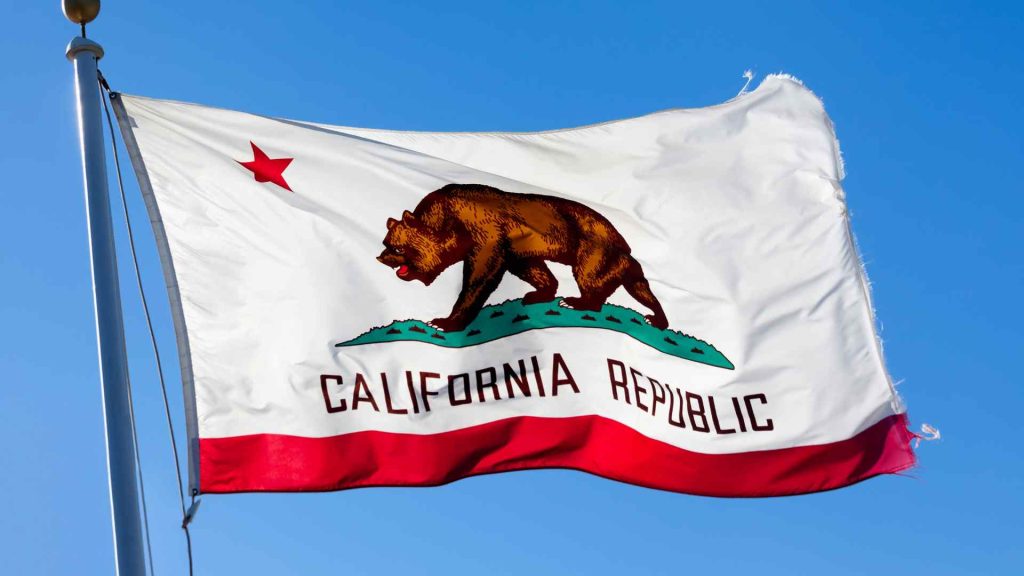
Uncommon and Regional Nicknames
El Dorado
Mythical Origins and Historical Pursuit of Wealth:
- The term “El Dorado” comes from Spanish explorers’ tales of a mythical city of gold, believed to be located in the New World.
- During the California Gold Rush, the state became synonymous with the quest for wealth, much like the legendary El Dorado.
Modern Interpretations and Uses:
- Today, “El Dorado” is used to refer to California’s rich history of exploration and the enduring allure of seeking fortune.
- It’s also the name of a county in Northern California, further cementing its place in the state’s identity.
Califa
Derived from the Legend of Queen Califia:
- The name “Califa” originates from the fictional Queen Califia, a mythical Black Amazon warrior queen who ruled over a rich island of gold.
- Spanish explorers, inspired by the legend, named the land California after this mythical queen.
Influence on Cultural and Literary Works:
- The story of Queen Califia has influenced numerous cultural and literary works, celebrating California’s mythical and legendary past.
- Statues and artwork depicting Queen Califia can be found throughout the state, honoring her as a symbol of California’s rich and diverse heritage.
The Left Coast
Political and Cultural Connotations:
- “The Left Coast” is a playful nickname reflecting California’s reputation for progressive politics and liberal social values.
- It highlights the state’s role as a trendsetter in social, environmental, and technological advancements.
Stereotypes and Realities:
- While the nickname emphasizes California’s liberal image, it also underscores the diversity of opinions and lifestyles within the state.
- The term is often used both affectionately and critically, depending on the context.
The Grape State
Wine Industry Significance:
- California is renowned for its wine industry, producing over 80% of American wine and being the fourth-largest wine producer in the world.
- Regions like Napa Valley and Sonoma are globally recognized for their premium wines.
Regions Famous for Vineyards and Wineries:
- Napa Valley, Sonoma County, and Paso Robles are some of the key regions contributing to California’s reputation as “The Grape State.”
- These areas attract wine enthusiasts from around the globe, further solidifying the nickname.
The Cereal Bowl of the Nation
Agricultural Productivity and Diversity:
- California’s Central Valley is often referred to as “The Cereal Bowl of the Nation” due to its extensive agricultural output.
- The region produces a significant portion of the nation’s grains, fruits, and vegetables, playing a crucial role in the U.S. food supply.
Key Crops and Economic Impact:
- Key crops include almonds, grapes, strawberries, and rice, among many others.
- The agricultural industry in California not only feeds millions but also contributes significantly to the state’s economy.
El Dorado
Mythical Origins and Historical Pursuit of Wealth:
- “El Dorado” traces back to Spanish legends of a city of gold, inspiring explorers and settlers during the Gold Rush.
- The pursuit of wealth and prosperity in California mirrored the legendary quest for El Dorado.
Modern Interpretations and Uses:
- Today, the term represents California’s history of exploration and the enduring dream of fortune.
- El Dorado is also the name of a county in Northern California, commemorating the state’s rich past.
Califa
Derived from the Legend of Queen Califia:
- The name “Califa” stems from the mythical Queen Califia, a powerful Black Amazon queen ruling over a golden island.
- Inspired by this legend, Spanish explorers named the land California.
Influence on Cultural and Literary Works:
- Queen Califia’s story has influenced many cultural and literary pieces, symbolizing California’s mythical heritage.
- Statues and artworks depicting Queen Califia honor her as a significant figure in the state’s diverse history.
The Left Coast
Political and Cultural Connotations:
- “The Left Coast” highlights California’s reputation for progressive politics and liberal values.
- The nickname reflects the state’s role as a pioneer in social, environmental, and technological advancements.
Stereotypes and Realities:
- While the nickname emphasizes California’s liberal image, it also represents the state’s diverse opinions and lifestyles.
- The term is used both affectionately and critically, depending on context.
The Grape State
Wine Industry Significance:
- California is a leading wine producer, contributing over 80% of American wine and being the world’s fourth-largest producer.
- Renowned regions like Napa Valley and Sonoma are key to California’s wine fame.
Regions Famous for Vineyards and Wineries:
- Napa Valley, Sonoma County, and Paso Robles attract global wine enthusiasts, reinforcing the “Grape State” nickname.
- These regions’ wineries and vineyards are celebrated worldwide for their premium wines.
The Cereal Bowl of the Nation
Agricultural Productivity and Diversity:
- California’s Central Valley is dubbed “The Cereal Bowl of the Nation” for its vast agricultural output.
- The region produces a substantial portion of the nation’s grains, fruits, and vegetables.
Key Crops and Economic Impact:
- Major crops include almonds, grapes, strawberries, and rice.
- The agricultural sector significantly contributes to California’s economy, feeding millions across the country.
This section delves into the lesser-known and region-specific nicknames for California, uncovering the rich history and diverse influences that have shaped the state’s identity.
These nicknames reflect California’s multifaceted character, from its mythical origins to its agricultural prowess and progressive spirit.
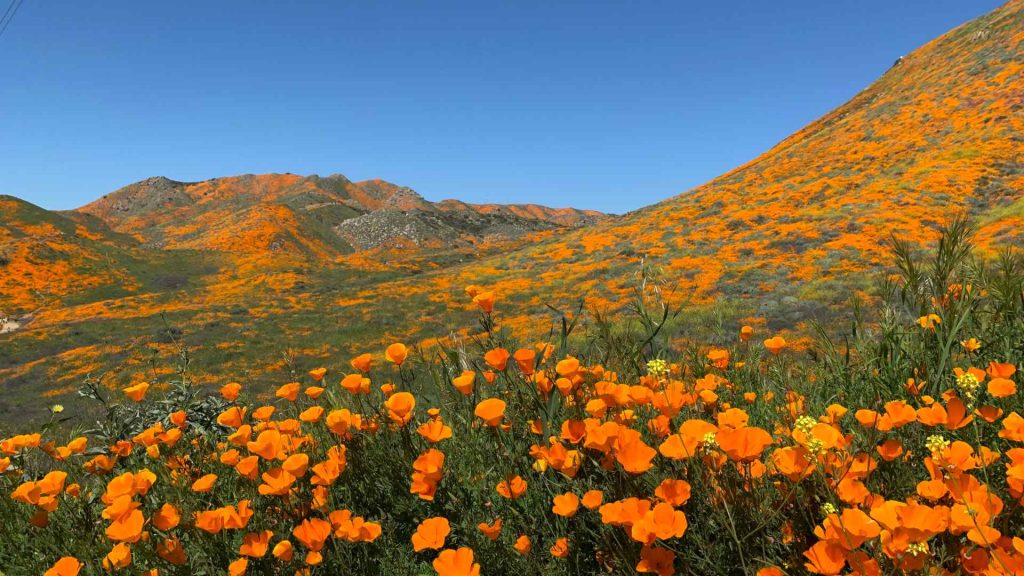
City-Specific Nicknames
Los Angeles – The City of Angels
Origins and Symbolism:
- “The City of Angels” translates from the original Spanish name, “El Pueblo de Nuestra Señora la Reina de los Ángeles,” which means “The Town of Our Lady the Queen of the Angels.”
- This nickname emphasizes Los Angeles’ rich Spanish and Mexican heritage, reflecting its origins as a Spanish mission town.
Hollywood Influence and Global Recognition:
- Los Angeles is synonymous with the entertainment industry, home to Hollywood, the epicenter of global film and television production.
- Known worldwide, “The City of Angels” attracts aspiring actors, filmmakers, and tourists seeking the glamour and excitement of Hollywood.
Cultural Melting Pot:
- Los Angeles is one of the most ethnically diverse cities in the world, with significant populations from Latin America, Asia, and beyond.
- This diversity is reflected in the city’s vibrant cultural scene, including festivals, cuisine, and arts.
San Francisco – The Golden Gate City
Golden Gate Bridge and Its Significance:
- “The Golden Gate City” derives from the iconic Golden Gate Bridge, a symbol of San Francisco and a marvel of modern engineering.
- Completed in 1937, the bridge spans the Golden Gate Strait, connecting San Francisco to Marin County and serving as a vital transportation link.
Tech Hub and Cultural Melting Pot:
- San Francisco is renowned as a global tech hub, home to Silicon Valley and numerous tech giants, startups, and venture capital firms.
- The city’s rich history as a cultural melting pot is evident in its diverse neighborhoods, including Chinatown, the Mission District, and the Castro.
Historic and Modern Landmarks:
- In addition to the Golden Gate Bridge, San Francisco boasts landmarks such as Alcatraz Island, Fisherman’s Wharf, and the Painted Ladies.
- The city is also known for its steep hills, cable cars, and historic Victorian architecture.
San Diego – America’s Finest City
Quality of Life and Attractions:
- “America’s Finest City” reflects San Diego’s reputation for high quality of life, with its mild climate, beautiful beaches, and numerous attractions.
- Key attractions include the San Diego Zoo, Balboa Park, and SeaWorld, drawing millions of visitors each year.
Military Presence and Historical Context:
- San Diego has a significant military presence, with major naval and marine bases contributing to the local economy and community.
- The city’s history as a military hub dates back to World War II, influencing its development and identity.
Outdoor Lifestyle and Recreation:
- San Diego’s favorable weather promotes an outdoor lifestyle, with activities such as surfing, hiking, and sailing being popular among residents and tourists.
- The city’s extensive coastline and natural parks offer numerous opportunities for outdoor recreation.
Sacramento – The Big Tomato
Agricultural Roots and Development:
- Sacramento earned the nickname “The Big Tomato” due to its history as a major center for tomato farming and processing.
- The city’s fertile land and favorable climate have long supported agricultural activities, contributing to its growth and development.
Capital City Dynamics and Role:
- As the capital of California, Sacramento plays a crucial role in the state’s political and administrative functions.
- The presence of the state government and related institutions has shaped the city’s economy and identity.
Cultural and Historical Attractions:
- Sacramento is home to several cultural and historical attractions, including the California State Capitol, Old Sacramento, and the Crocker Art Museum.
- The city’s rich history and heritage are celebrated through various festivals and events.
Oakland – The Town
Community and Cultural Diversity:
- “The Town” is a beloved nickname for Oakland, reflecting its strong sense of community and cultural diversity.
- Known for its vibrant arts scene, diverse population, and social activism, Oakland is a city with a unique and dynamic character.
Evolution and Modern Identity:
- Historically an industrial hub, Oakland has evolved into a center for culture, technology, and innovation.
- The city’s modern identity is shaped by its thriving arts community, culinary scene, and progressive values.
Landmarks and Attractions:
- Key landmarks in Oakland include Lake Merritt, the Oakland Museum of California, and Jack London Square.
- The city’s sports teams, such as the Oakland Athletics and the Golden State Warriors, also contribute to its identity and pride.
This section explores the unique nicknames of major Californian cities, each with its own distinct identity and cultural significance.
From Los Angeles’ entertainment allure to San Francisco’s iconic landmarks, San Diego’s sunny charm, Sacramento’s agricultural roots, and Oakland’s vibrant community, these city-specific nicknames reflect the rich diversity and dynamic character of California.
Nicknames Reflecting California’s Diversity
Silicon Valley
Tech Industry and Innovation:
- “Silicon Valley” refers to the southern part of the San Francisco Bay Area, renowned for its high concentration of tech companies and startups.
- The nickname originated in the 1970s, highlighting the region’s role in the development of silicon-based microchips and semiconductors.
Global Impact and Regional Growth:
- Home to tech giants like Apple, Google, and Facebook, Silicon Valley is a global center for innovation, technology, and venture capital.
- The region’s growth has transformed it into a significant economic powerhouse, attracting talent from around the world.
Cultural and Economic Contributions:
- Silicon Valley’s influence extends beyond technology, impacting global culture, business practices, and lifestyles.
- The area is known for fostering a culture of entrepreneurship, innovation, and risk-taking.
The Central Valley
Agricultural Heartland and Economic Contributions:
- The Central Valley is often called the “breadbasket” or “heartland” of California due to its extensive agricultural production.
- Stretching 450 miles from Redding to Bakersfield, the valley produces over a third of the country’s vegetables and two-thirds of its fruits and nuts.
Community and Lifestyle:
- The Central Valley’s economy is deeply rooted in agriculture, with family-owned farms and large agribusinesses driving the local economy.
- The region’s rural lifestyle is characterized by tight-knit communities, agricultural fairs, and a strong connection to the land.
Environmental and Water Challenges:
- Despite its productivity, the Central Valley faces significant environmental challenges, including water scarcity and soil degradation.
- Efforts to address these issues include water conservation measures and sustainable farming practices.
The Inland Empire
Geographic and Economic Significance:
- The Inland Empire, located east of Los Angeles, encompasses Riverside and San Bernardino counties.
- Historically an agricultural region, it has transformed into a major logistics and warehousing hub due to its proximity to major ports and transportation routes.
Growth and Development Trends:
- The Inland Empire has experienced rapid population growth and urban development, with new housing, businesses, and infrastructure projects.
- This growth has led to increased economic opportunities and challenges related to urban sprawl and environmental sustainability.
Cultural and Recreational Opportunities:
- The region offers diverse cultural and recreational activities, including hiking in the San Bernardino Mountains, exploring the Joshua Tree National Park, and visiting local museums and theaters.
- The Inland Empire’s cultural diversity is reflected in its festivals, cuisine, and community events.
Wine Country
Napa and Sonoma Regions:
- Napa Valley and Sonoma County are world-famous wine-producing regions located in Northern California.
- These areas are celebrated for their scenic vineyards, premium wines, and luxurious wine-tasting experiences.
Wine Tourism and Industry Impact:
- Wine tourism is a major economic driver in these regions, attracting millions of visitors annually who come to sample wines, tour vineyards, and enjoy gourmet dining.
- The success of the wine industry has fostered a culture of excellence in viticulture and winemaking.
Cultural and Environmental Sustainability:
- Both Napa and Sonoma emphasize sustainable winegrowing practices, balancing environmental stewardship with economic viability.
- Initiatives include organic farming, water conservation, and efforts to preserve the natural beauty of the landscape.
The Bay Area
Regional Unity and Diversity:
- The Bay Area includes major cities like San Francisco, Oakland, and San Jose, as well as numerous smaller towns and communities.
- Known for its cultural diversity, the Bay Area is a melting pot of ethnicities, languages, and traditions.
Tech, Culture, and Lifestyle:
- The region is a hub for technology and innovation, with Silicon Valley playing a central role in the global tech industry.
- The Bay Area’s cultural scene is vibrant, with world-class museums, theaters, music venues, and a thriving culinary landscape.
Environmental and Social Initiatives:
- The Bay Area is known for its progressive values and environmental initiatives, including efforts to combat climate change, promote renewable energy, and enhance public transportation.
- Social movements advocating for civil rights, LGBTQ+ equality, and economic justice have deep roots in the region.
This section highlights the diverse nicknames reflecting California’s multifaceted character.
From the tech-driven Silicon Valley to the agricultural heartland of the Central Valley, the rapidly growing Inland Empire, the picturesque Wine Country, and the culturally rich Bay Area, these California nicknames capture the essence of different regions within the state.
Each area contributes uniquely to California’s identity, showcasing its economic, cultural, and environmental diversity.
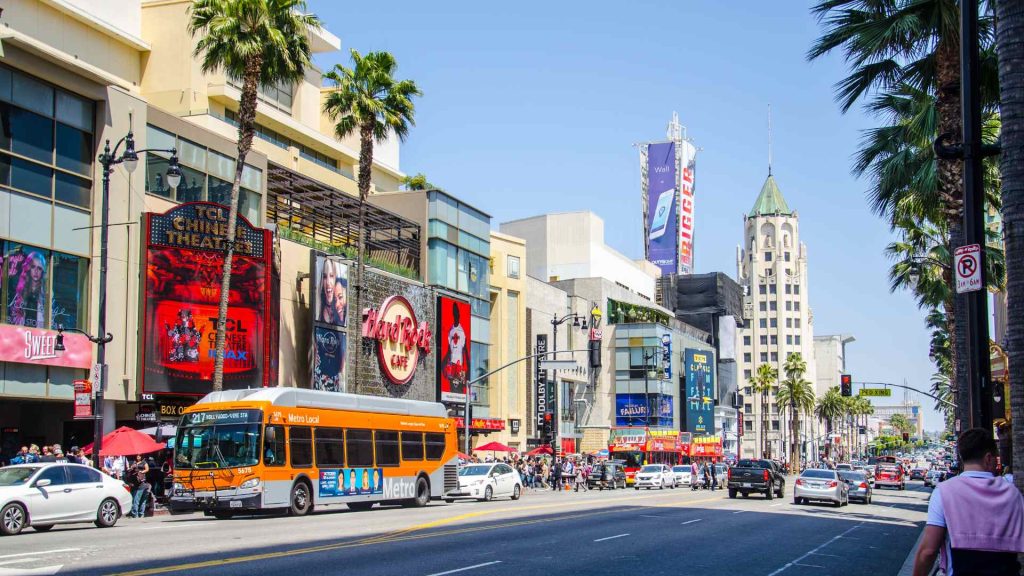
Fun and Quirky Nicknames
The Left Coast
Surf Culture and Beach Lifestyle:
- “The Left Coast” playfully refers to California’s location on the western edge of the United States, often associated with its vibrant surf culture and beach lifestyle.
- Surfing hotspots like Huntington Beach and Malibu have helped shape California’s identity as a paradise for surfers and beachgoers.
Political and Social Stereotypes:
- The nickname also reflects California’s reputation for progressive politics and liberal social values.
- Often used both affectionately and critically, “The Left Coast” underscores the state’s influence on national trends in social and environmental policies.
Cultural Influences:
- California’s music, fashion, and lifestyle have left a lasting impact on global culture, reinforcing its image as a trendsetter.
- Iconic events like Coachella and the Hollywood film industry further cement the state’s cultural significance.
Tinseltown
Hollywood Glamour and Film Industry:
- “Tinseltown” is a nickname for Hollywood, the heart of the global film and entertainment industry.
- The term evokes images of movie stars, red carpets, and the glitz and glamour associated with the silver screen.
Pop Culture References:
- Hollywood’s influence permeates pop culture, with countless movies, TV shows, and celebrities shaping public perceptions of California.
- The Walk of Fame, Hollywood Sign, and numerous film studios are major tourist attractions, drawing millions of visitors each year.
Behind the Scenes:
- Despite the glamorous exterior, Hollywood is also a hub of intense creative work, with writers, directors, and crews working tirelessly to produce entertainment enjoyed worldwide.
- The nickname “Tinseltown” captures both the allure and the reality of the entertainment industry.
Hollyweird
Eccentricities and Unique Culture:
- “Hollyweird” is a humorous and affectionate nickname highlighting Hollywood’s eccentric and unconventional aspects.
- Known for its creative and often quirky inhabitants, Hollywood has a reputation for being a place where anything goes and everyone is welcome.
Entertainment Industry Quirks:
- The nickname reflects the diverse and sometimes bizarre elements of the entertainment industry, from avant-garde art to unconventional fashion.
- Hollywood’s unique culture attracts a wide range of artists, performers, and dreamers, all contributing to its vibrant and eclectic atmosphere.
Cultural Impact:
- “Hollyweird” captures the spirit of innovation and risk-taking that defines Hollywood, making it a global center for new ideas and creative expression.
- The nickname underscores Hollywood’s role as a place where unconventional and groundbreaking art can thrive.
The OC
Orange County’s Affluent and Laid-Back Reputation:
- “The OC” refers to Orange County, a region known for its affluence, beautiful beaches, and laid-back lifestyle.
- Popularized by the TV show “The O.C.,” the nickname highlights the area’s appeal as a luxurious and relaxed place to live and visit.
TV and Media Portrayals:
- The nickname gained widespread recognition through the hit television series “The O.C.,” which depicted the lives of affluent teenagers in Newport Beach.
- The show’s portrayal of the region’s picturesque scenery and upscale lifestyle contributed to its glamorous image.
Tourism and Local Attractions:
- Orange County boasts attractions such as Disneyland, Laguna Beach, and numerous high-end shopping centers, drawing millions of tourists annually.
- The area’s pleasant climate and scenic coastline make it a popular destination for both residents and visitors.
Surf City
Huntington Beach and Surf Culture:
- “Surf City” is a nickname for Huntington Beach, known for its strong surfing culture and iconic beach lifestyle.
- The city hosts the annual U.S. Open of Surfing, one of the largest surfing competitions in the world, attracting surfers and spectators from around the globe.
Festivals and Local Pride:
- Huntington Beach celebrates its surf culture with various events and festivals, including the Surf City USA Marathon and the International Surfing Museum.
- The nickname “Surf City” reflects the city’s pride in its surfing heritage and its commitment to maintaining its status as a top surfing destination.
Economic and Cultural Impact:
- Surfing has a significant economic impact on Huntington Beach, driving tourism and supporting local businesses.
- The city’s vibrant surf culture influences its fashion, music, and community events, making it a unique and lively place to live and visit.
This section explores some of California’s fun and quirky nicknames, each highlighting different aspects of the state’s unique culture and lifestyle.
From the progressive and beach-loving “Left Coast” to the glamorous yet eccentric “Tinseltown” and “Hollyweird,” the luxurious “OC,” and the surf-centric “Surf City,” these nicknames capture the playful and diverse spirit of California.
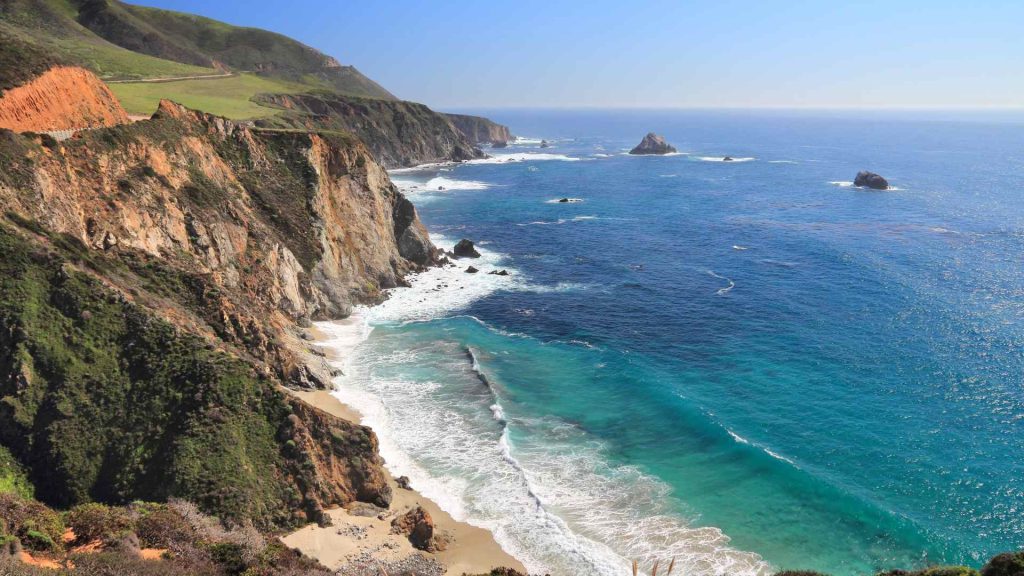
Historical and Cultural Influences on Nicknames
Gold Rush Era
Impact on State Identity and Nicknames:
- The California Gold Rush (1848-1855) was a pivotal event that shaped the state’s identity and economy.
- The rush for gold attracted hundreds of thousands of prospectors, earning California the nickname “The Golden State.”
- The influx of fortune seekers and the rapid growth of settlements established California as a land of opportunity and adventure.
Legacy in Modern Times:
- The spirit of the Gold Rush continues to influence California’s culture and identity, symbolizing perseverance, innovation, and the pursuit of dreams.
- Historic sites like Sutter’s Mill, where gold was first discovered, and towns like Coloma and Sacramento preserve the legacy of this transformative era.
Cultural Celebrations and Events:
- California commemorates its Gold Rush heritage through festivals, reenactments, and museum exhibits, celebrating the adventurous spirit of the forty-niners.
- Events like Gold Rush Days in Sacramento offer immersive experiences, bringing the history and excitement of the era to life for residents and visitors.
Spanish and Mexican Heritage
Influence on Place Names and Nicknames:
- California’s Spanish and Mexican heritage is deeply embedded in its place names and nicknames, reflecting the region’s history under Spanish and Mexican rule.
- Cities like Los Angeles, San Francisco, and San Diego, as well as numerous missions and landmarks, carry names that honor this rich cultural legacy.
Cultural Integration and Preservation:
- Spanish and Mexican influences are evident in California’s architecture, cuisine, and traditions, contributing to the state’s diverse cultural tapestry.
- Celebrations such as Cinco de Mayo, Día de los Muertos, and various local fiestas highlight the enduring impact of these cultures.
Historic Landmarks and Contributions:
- The California missions, established by Spanish missionaries in the 18th century, are significant historical landmarks that illustrate the state’s colonial past.
- These missions, along with other historic sites, play a crucial role in preserving and educating about California’s Spanish and Mexican heritage.
Native American Roots
Indigenous Names and Their Meanings:
- Many of California’s place names and nicknames have origins in Native American languages, reflecting the state’s indigenous heritage.
- Names like Yosemite, derived from the Miwok word for “killer,” and Malibu, from the Chumash word “Humaliwo,” meaning “the surf sounds loudly,” honor the state’s Native American roots.
Recognition and Respect for Original Inhabitants:
- Efforts to recognize and respect the contributions of Native American tribes include preserving indigenous names, supporting cultural programs, and acknowledging the history and rights of Native peoples.
- Museums, cultural centers, and educational initiatives work to promote understanding and appreciation of California’s indigenous heritage.
Cultural Contributions and Traditions:
- Native American tribes in California have rich cultural traditions, including art, music, dance, and storytelling, which continue to influence the state’s cultural landscape.
- Powwows, craft fairs, and other events celebrate Native American culture, fostering community and preserving these important traditions.
Immigration and Diversity
Contributions to Nickname Diversity:
- California’s history of immigration has brought a rich diversity of cultures, languages, and traditions, each contributing to the state’s unique identity and nicknames.
- Immigrant communities have introduced new customs, cuisines, and cultural practices, enriching the state’s social fabric.
Cultural Melting Pot and Its Reflections:
- Cities like Los Angeles, San Francisco, and San Diego are renowned for their diverse populations, with vibrant neighborhoods representing various ethnic groups.
- Cultural districts such as Chinatown, Little Italy, and Koreatown highlight the contributions of immigrant communities to California’s nickname diversity.
Celebration of Multicultural Heritage:
- Festivals, parades, and cultural events across California celebrate the state’s multicultural heritage, showcasing the traditions of various immigrant communities.
- Events like the San Francisco Chinese New Year Parade, Los Angeles’ Dia de los Muertos celebrations, and the Greek Festival in San Diego exemplify the state’s inclusive and celebratory spirit.
This section delves into the historical and cultural influences that have shaped California’s diverse nicknames.
From the transformative impact of the Gold Rush and the enduring legacy of Spanish and Mexican heritage to the deep roots of Native American culture and the rich contributions of immigrant communities, these influences highlight the multifaceted identity of California.
Each cultural thread weaves into the vibrant tapestry of the state, enriching its character and contributing to its numerous and varied nicknames.
Modern Interpretations California Nicknames
Tech Boom Influence
Evolving Nicknames Reflecting Technological Advancements:
- The rapid growth of the tech industry has introduced new nicknames for California, particularly for regions like Silicon Valley.
- Terms like “Tech Mecca” and “Innovation Hub” reflect the state’s leadership in technological advancements and digital innovation.
Future Projections and Potential New Nicknames:
- As California continues to innovate, new nicknames may emerge that capture its evolving identity in the tech landscape.
- Future trends in artificial intelligence, biotechnology, and renewable energy could inspire nicknames such as “AI Alley” or “Green Tech Valley.”
Cultural Impact of the Tech Industry:
- The tech boom has significantly influenced California’s culture, attracting a global workforce and fostering a dynamic, entrepreneurial spirit.
- The integration of technology into everyday life, from smart cities to digital entertainment, further shapes the state’s modern identity.
Environmental Movements
Nicknames Related to Eco-Friendly Initiatives:
- California’s leadership in environmental sustainability has inspired nicknames emphasizing its green initiatives, such as “Eco State” and “Green California.”
- The state’s commitment to renewable energy, conservation, and climate action is a defining aspect of its modern identity.
Sustainability and Conservation Efforts:
- California has pioneered numerous environmental policies and initiatives, from solar power adoption to plastic bag bans.
- Efforts to protect natural resources and promote sustainable living are central to the state’s vision for the future.
Community Involvement and Advocacy:
- Grassroots movements and community organizations play a vital role in advancing California’s environmental goals.
- Events like Earth Day celebrations, beach cleanups, and urban gardening projects reflect the state’s collective commitment to a sustainable future.
Pop Culture and Media
Influence of Movies, Music, and TV on Nicknames:
- Pop culture and media have a significant impact on California’s nicknames, often reflecting the state’s glamorous and trendsetting image.
- Hollywood’s influence can be seen in nicknames like “Tinseltown” and “Hollyweird,” while the music scene inspires names like “Rock City” for Los Angeles.
Celebrity Endorsements and Popular Trends:
- Celebrities and influencers often shape public perceptions of California, contributing to its evolving nickname landscape.
- Endorsements by famous personalities can popularize new nicknames, reflecting current trends and cultural moments.
Global Perception and Local Identity:
- California’s portrayal in movies, TV shows, and music shapes its global image, often highlighting its beaches, cities, and lifestyle.
- The state’s diverse and dynamic culture continues to evolve, with new nicknames emerging to capture its ever-changing identity.
Social Movements and Cultural Shifts
Nicknames Reflecting Progressive Values:
- California’s reputation for progressive values is evident in nicknames like “The Left Coast” and “The Golden State of Mind.”
- The state’s leadership in social justice, LGBTQ+ rights, and environmental activism shapes its modern identity and influences new nicknames.
Future Social Trends and Potential Nicknames:
- Emerging social trends and cultural shifts may inspire new nicknames that reflect California’s evolving values and priorities.
- Issues such as gender equality, racial justice, and mental health awareness could give rise to nicknames like “Equality State” or “Mindful California.”
Role of Diversity and Inclusion:
- California’s commitment to diversity and inclusion is a cornerstone of its identity, celebrated through festivals, community events, and inclusive policies.
- Nicknames that highlight the state’s multiculturalism and inclusivity, such as “Melting Pot State” or “Rainbow California,” reflect these values.
Health and Wellness Trends
Nicknames Inspired by Healthy Living:
- California’s emphasis on health and wellness inspires nicknames that reflect its focus on a balanced and active lifestyle.
- Names like “Wellness Wonderland” and “Healthy Haven” capture the state’s dedication to fitness, organic food, and holistic well-being.
Impact of the Wellness Industry:
- The wellness industry, including yoga studios, organic markets, and wellness retreats, plays a significant role in shaping California’s modern image.
- The state’s reputation for health-conscious living attracts residents and visitors seeking a healthier lifestyle.
Community and Individual Wellness Initiatives:
- California’s communities actively promote wellness through initiatives like farmers’ markets, bike lanes, and public parks.
- These efforts contribute to the state’s identity as a place that prioritizes well-being and quality of life.
This section explores modern interpretations and future trends that influence California’s nicknames.
From the tech boom and environmental movements to pop culture, social shifts, and health trends, these factors shape the state’s evolving identity.
As California continues to innovate and lead in various fields, new nicknames will emerge, reflecting its dynamic character and diverse influences.
